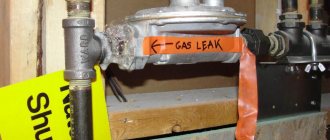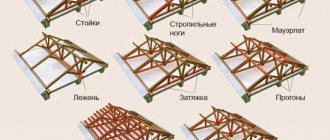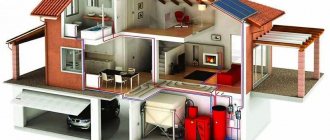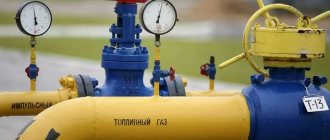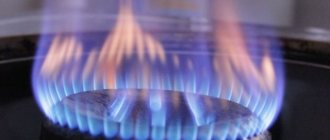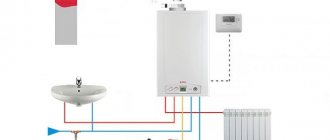How to convert liters of liquefied gas to cubic meters?
To convert liters of gas to cubic meters, divide the number of liters by 1000. To convert cubic meters of gas to liters, use the opposite rule: multiply the number of cubic meters of gas by 1000.
Interesting materials:
How to clean your iron from plaque? How to clean an iron with a steam generator from scale? How to clean a Tefal iron from scale? How to clean a Tefal iron? How to clean an iron at home? How to clean your iron? How to clean a bathtub covered with acrylic? How to clean a bathtub covered with liquid acrylic? How to clean a refurbished bathtub? How to clean a bathtub with an acrylic coating?
Calculation example
How and why gas is liquefied: production technology and scope of use of liquefied gas
It is necessary to determine how many cubic meters of gas one cylinder with a 50-liter propane-butane mixture contains if you pass its contents through a gas meter:
- the mass of the gas mixture pumped into it is about 21 kilograms;
- volume in m³ is equal to 50/5 = 10;
- after adjusting for the filling of the cylinder, we get 10 × 0.85 = 8.5 m³.
This indicator may vary depending on the ambient temperature, since when it decreases, the pressure inside the container decreases, with a corresponding decrease in the volume of fuel.
But the use of liters of gas in cubic meters is only relevant as an approximate calculation. When purchasing this type of fuel, kilograms of the gas mixture and the pressure inside the container are important, and when using individual metering devices, a standard unit of measurement is used - cubic meters, the conversion procedure of which does not depend on the composition of the gas and is determined by a simple arithmetic calculation in the ratio of 1 to 1000.
Hello dear employees of the newspaper “Upravdom”!
I installed a gas meter, and it was surprising that the consumption was 1 m3 per month, but at 102 rubles. 99 kopecks for 1 cubic Without a meter, the cost was 48.61 kopecks, and the amount per person was 291 rubles. 66 kopecks Why do they set such standards when a person needs 1m3 alone? And why are the prices different? How to explain this?
Alevtina Turistov 23a
The price of liquefied gas is the same for the population who pay for gas use using metering devices and according to consumption standards.
Thus, if the monthly standard for weight per person is translated into the standard for volume per person per month, we get 6.0 kg: 2.1186 = 2.832 m3. And then per month it turns out 2.832 m3 * 102.99 rubles / m3 = 291 rubles 66 kopecks. As you can see, the prices are the same, and there is no reason to worry. Alevtina, an error initially crept into your calculations: 48.61 is the price per kg of gas, not per m3.
The Region51.com website is the holder of official permission from the editors of the UPRAVDOM newspaper to reprint newspaper materials. Reproduction of the material in any form on other Internet resources is prohibited and will be prosecuted by the copyright holder by law.
Electric heating costs with a two-tariff meter and a heat accumulator.
Let's say we installed a large tank of water in the basement of our house and heat it during the night tariff period. And during the day, during the period of the daily tariff, we use the stored heat to compensate for the heat loss of our building. In fairness, it should be noted that such a system will only work if there is sufficient electrical power supplied. After all, this heat accumulator needs to be heated in a very short time. So, heating costs will be:
150*5*24*0.92 = 16560 rubles
Energy unit conversion table
| IN | ||||||||||||||||||||
| FROM | watt/hour | thermal units | joules | calories | natural gas, m3 | oil, barrels | oil, tons | coal, tons | LNG | |||||||||||
| kW/h | MW/h | therm | mmbtu | KJ | GJ | Kcal | Gcal | m 3 | thousand m 3 | million m3 | billion m3 | bar | million bar | T. | million tons | T. | million tons | tons | ||
| kilowatt/hour | kW/h | 1 | 0.001 | 0.0341 | 0.0034 | 3600 | 0.0036 | 859.85 | 0.00009 | 0.093 | 900000 | 900000000 | 9E+11 | 0.00059 | 59000000000 | 800000 | 8E+11 | 0.0001 | 14000000000 | 700000 |
| megawatt/hour | MW/h | 1 | 1000 | 34.12 | 3.412 | 4000000 | 3,6 | 859845 | 0.8598 | 93 | 0.093 | 900000 | 900000000 | 0.59 | 59000000 | 0.08 | 800000000 | 0.14 | 14000000 | 0.066 |
| baths | therm | 1 | 29.307 | 0.0293 | 0.1 | 105506 | 0.1055 | 25200 | 0.0252 | 2,72 | 0.0027 | 3000000 | 3000000000 | 0.17 | 17000000 | 0.0024 | 2400000000 | 0.004 | 4000000000 | 0.0019 |
| dekatherms | mmbtu | 1 | 293.07 | 0.293 | 10 | 1000000 | 1.0551 | 252000 | 0.252 | 27,2 | 0.0272 | 300000 | 300000000 | 1,7 | 1700000 | 0.024 | 240000000 | 0.04 | 400000000 | 0.019 |
| Kilozhdoul | KJ | 1 | 0.0003 | 30000000 | 9000000 | 90000000 | 1000000 | 0.2388 | 20000000 | 300000 | 300000000 | 3E+11 | 3E+14 | 16000000 | 1.6E+13 | 16000000 | 1.6E+13 | 380000000 | 3.8E+14 | 180000000 |
| Gigajoule | GJ | 1 | 277.8 | 0.2778 | 9.478 | 0.9478 | 1000000 | 238800 | 0.2388 | 26 | 0.026 | 300000 | 300000000 | 0.16 | 16000000 | 0.16 | 16000000 | 0.038 | 380000000 | 0.018 |
| kilocalories | Kcal | 1 | 0.0012 | 1000000 | 400000 | 4000000 | 4.1868 | 4000000 | 1000000 | 0.0001 | 10000000 | 10000000000 | 1E+13 | 66000000 | 6.6E+13 | 930000000 | 9.3E+14 | 16000000 | 1.6E+13 | 760000000 |
| gigacalories | Gcal | 1 | 1163 | 1.163 | 39.68 | 3.968 | 4000000 | 4.1868 | 1000000 | 110 | 0.11 | 0.0001 | 10000000 | 0.66 | 66000000 | 0.093 | 930000000 | 0.16 | 16000000 | 0.076 |
| natural gas, m3 | m3 | 1 | 11 | 0.011 | 367 | 36.7 | 38722 | 0.0387 | 9249 | 0.0092 | 0.001 | 1000000 | 1000000000 | 0.0061 | 6100000000 | 0.0008 | 83000000000 | 0.0015 | 1500000000 | 0.0007 |
| thousand m3 | 1 | 11000 | 11 | 367000 | 36700 | 40000000 | 38.722 | 9000000 | 9.249 | 1000 | 0.001 | 1000000 | 6,1 | 6100000 | 0.83 | 83000000 | 1,5 | 1500000 | 0.71 | |
| million m3 | 1 | 10000000 | 11000 | 400000000 | 40000000 | 40000000000 | 38722 | 9000000000 | 9249 | 1000000 | 1000 | 0.001 | 6100 | 0.0061 | 830 | 0.00083 | 1500 | 0.0015 | 710 | |
| billion m3 | 1 | 10000000000 | 10000000 | 4E+11 | 40000000000 | 4E+13 | 40000000 | 9E+12 | 9000000 | 1000000000 | 1000000 | 1000 | 6100000 | 6,1 | 830000 | 0.83 | 2000000 | 1,5 | 710000 | |
| oil, barrels | bar | 1 | 1700 | 1,7 | 60 | 6 | 6000000 | 6,3 | 2000000 | 1,5 | 160 | 0.16 | 0.0002 | 20000000 | 1000000 | 0.14 | 14000000 | 0.23 | 23000000 | 0.1 |
| million bar | 1 | 2000000000 | 200000 | 60000000 | 6000000 | 6E+12 | 6000000 | 2E+12 | 2000000 | 200000000 | 160000 | 160 | 0.16 | 1000000 | 140000 | 0.14 | 2300000 | 0.23 | 100000 | |
| oil, tons | T. | 1 | 12700 | 12,7 | 425 | 42.5 | 50000000 | 45 | 10000000 | 11 | 1200 | 1,2 | 0.0012 | 1000000 | 7,5 | 7500000 | 1000000 | 1,7 | 1700000 | 0.8 |
| million tons | 1 | 10000000000 | 10000000 | 400000000 | 40000000 | 5E+13 | 50000000 | 1E+13 | 10000000 | 1000000000 | 1000000 | 1200 | 1,2 | 7500000 | 7,5 | 1000000 | 2000000 | 1,7 | 800000 | |
| coal, tons | T. | 1 | 7100 | 7,1 | 250 | 25 | 30000000 | 26 | 6000000 | 6,3 | 700 | 0.7 | 0.0007 | 70000000 | 4,3 | 4300000 | 0.6 | 60000000 | 1000000 | 0.5 |
| million tons | 1 | 7000000000 | 700000 | 300000000 | 30000000 | 3E+13 | 30000000 | 6E+12 | 6000000 | 700000000 | 700000 | 700 | 0.7 | 4300000 | 4,3 | 600000 | 0.6 | 1000000 | 500000 | |
| LNG | tons | 1 | 14000 | 14 | 520 | 52 | 50000000 | 55 | 10000000 | 13 | 1400 | 1,4 | 0.0014 | 1000000 | 8,9 | 8900000 | 1,2 | 1200000 | 1,9 | 1900000 |
Gas cylinder device
A container for storing and transporting technical gas is a cylinder of a certain shape and volume, which has a hole in the upper part for installing a valve.
The delivery set of gas tanks includes:
- valve;
- prefabricated body consisting of a shell, upper and lower bottom. For the manufacture of vessels, high-quality steel or composite materials are used;
- shoe - a support designed to allow the container to be installed in a vertical position;
- protective cap is a cylinder design element that protects the valve from damage during transportation and operation.
Gas cylinder device
Sometimes a gearbox may be included in the package. This is what is called a pressure regulating device.
Gas leaves the cylinder through the valve. This device consists of a body made of metal, a valve, and a control steering wheel. The body is made in the form of a tee. One part is designed to install it in a container. The other one is for securing the control valve stem and the side one is for installing the plug.
The valve includes a stem and a valve. It is the valve that controls the movement of gas through the valve. The rod serves to transmit torque from the control wheel to the valve.
Internal contents of the gas cylinder
In fact, the cylinder resembles an ordinary lighter. Inside the container there is gas in two states of aggregation. In the lower part of the volume there is liquid, in the upper part there is gas.
In order to know what gas is in the cylinders, they are painted in different colors and marked with the name of the technical gas. For example, oxygen cylinders are painted blue and labeled “OXYGEN.”
Painted in different colors and marked with the name of the technical gas
Metal and composite gas cylinders
On the territory of our country there are several GOSTs regulating technical conditions for gas containers. In particular, GOST 949-73 regulates standards for steel vessels with a volume of 0.4 to 50 liters and operating at pressures from 9.8 to 19.6 MPa.
Metal cylinders are rightfully considered the optimal solution to the problem of storing and transporting technical gases. For the production of cylinders, low-carbon or alloy steel alloys are used. Cylinders are produced with a volume from 5 to 50 liters and a weight from 4 to 22 kg. Containers with a volume of 50 liters must be installed outdoors in a metal box specially made for this purpose. Containers with a smaller volume can be installed indoors, for example, in a garage or repair shop.
In addition to cylinders made of steel, products made of composites are used for storing and transporting gas.
They have the following advantages:
- Light weight, the difference between cylinders of the same volume can reach 70%.
- Increased resistance to shock loads. Explosion proof, even when exposed to open flame.
- The design of the composite cylinder is made in such a way that gas leakage is practically impossible.
- The polymer materials used in the manufacture of the cylinder eliminate the occurrence of corrosion and the formation of sparks.
- Composite vessels have an interesting appearance.
For the manufacture of cylinders of this type, fiberglass and epoxy resins are used.
To ensure the safe operation of polymer vessels, the following measures have been taken:
- Installing an overpressure relief valve.
- Installation of a melting insert.
As the temperature rises, the gas begins to increase in volume and, as a result, its excess is formed. They create excess pressure on the vessel. A safety valve is designed to eliminate excess pressure. It opens when a certain pressure level is reached.
Under the influence of elevated temperature, the pressure inside the vessel also increases, in this case the fuse-link is triggered. The insert will melt and form a hole through which excess gas escapes. But, after the fuse link has tripped, the container must be disposed of.
Containers of different volumes, made of composite materials, are designed to operate at temperatures from -40 to +60 degrees.
Design, volume and marking of gas vessels
The design, volume and marking of gas vessels are regulated by GOST 15860-84 (steel cylinders), GOST R 55559-2013 (composite vessels).
Propane-butane and fuel pellets: how to heat with them
The operating principle of a heating system with propane-butane is based on the use of an LPG storage tank - a gas holder, usually located underground a few meters from the house. In addition, a gas boiler is used, which, in fact, converts gas into thermal energy. To fully supply your home with gas, it is enough to refill the gas tank once or twice a year. Read more about this in the article: autonomous heating with propane butane.
Advantages of autonomous gasification:
- independent gas supply;
- high efficiency;
- low refueling frequency;
- a warm home at any time;
- hot water.
You can find more articles from our blog on this topic here.
The advantages of LPG and gas holder cannot be denied
When wondering what is more expensive – a kilowatt of propane butane or pellets, you need to understand the specifics of using fuel pellets. For their combustion, special solid fuel boilers are used, which are capable of regulating the supply of fuel and the release of thermal energy. Of course, such equipment costs a lot (from 150,000 rubles), however, its efficiency is an order of magnitude greater than that of a conventional oven. Some models allow you to provide not only comfortable indoor conditions, but also organize hot water supply.
Heating costs with wood.
Calculating the cost of heating with wood is quite difficult. It is difficult to determine the price of firewood. Someone will go to the nearest forest, drag a log, saw it, chop it and put it in a woodpile. In this case, the price of firewood will be equal to 0. However, is this true? Let's count like capitalists. How much time will you spend on this log? Let's say one day. How much does your working day cost? Let’s say 1,500 rubles (based on the average salary in Moscow). You will be working on a day off, so you need to take into account the bonus for working on a day off (at least 40%). In total, a working day will cost approximately 2,500 rubles. It is unlikely that you will be able to prepare more than one cubic meter of firewood during this working day. Thus, a cubic meter of firewood costs about 2,500 rubles. If you buy ready-made firewood, then the price of a cubic meter of birch logs stacked in a woodpile will be 1,350 rubles (though, excluding delivery). The weight of one cubic meter of firewood is approximately 600 kg. Thus, the cost of 1 kg of firewood will be 2 rubles 25 kopecks. The heat of combustion of birch logs is approximately 10220 kJ/kg. The boiler efficiency will be approximately 90%. Thus, the amount of heat released during the combustion of 1 kilogram of firewood will be:
10220/10*2.78 = 2841 W or 2.84 kW
The cost of 1 kW of heat, taking into account the boiler efficiency, will be:
2.25/2.84/0.9 = 0.88 rub. or 88 kopecks
The total cost of heating our house with wood for the heating season will be:
18000*0.88 = 15840 rubles.
The approximate consumption of firewood during the heating period will be slightly less than 12 cubic meters.
Physical meaning of translation
In a physical sense, everything is quite simple. The translation is carried out in the same way for any gases, liquids or bulk materials as follows:
- 1 cubic meter contains 1000 liters,
- 1 liter equals 0.001 cubic meters
- the table shows the quantity contained in 1 cube (1 cube = 1000 cubic decimeters, etc.).
For example, 15 cubic meters of natural gas used by the meter equals 15,000 liters. When converting these values, the temperature of the fuel, the amount of impurities and other factors do not matter.
Costs of heating a house with pellets.
Pellets are calibrated granules consisting of pressed sawdust. The main advantage of pellets is the ability to automate the heating process. Also, during the production of pellets, special attention is paid to removing moisture from the finished product, thereby increasing the specific heat of combustion. The specific heat of combustion of pellets will be approximately 17500 kJ/kg. Average price 1 kg. pellets in Moscow - 10 rubles per kilogram. Boiler efficiency is approximately 90%. Thus, the amount of heat generated by 1 kg of pellets will be:
17500/10*2.78 = 4865 W or 4.87 kW
The cost of 1 kW of heat when heating with pellets will be:
10/4.78/0.9 = 2 rub. 32 kopecks
The total cost of heating a house with pellets for the heating season will be:
18000*2.32 = 41760 rubles
The approximate consumption of pellets for heating will be just over 4 tons.
What is the weight of a cubic meter of water
The weight of 1 liter is usually taken as 1 kilogram, therefore, 1 cubic meter of water fits in one ton. But this is not entirely true. In fact, weight is influenced by many factors: pressure, temperature, the state of aggregation in which it is located. Therefore, a ton of water does not always contain 1000 kilograms.
| Weight measure | Liquid state | Solid state (ice from distilled liquid) | Solid state (pure snow) |
| Glass (250 ml), g | 249,6 | 229 | 12,5-112,5 |
| 1 liter, g | 298,2 | 917 | 50-450 |
| Twelve liter bucket, kg | 11,98 | 11 | 5-15 |
| Cubometer, kg | 998,2 | 917 | 100-450 |
The weight of snow directly depends on its density, which is influenced by the area in which the precipitation occurred and the time that has passed since the snowfall. The density of newly fallen snow is 0.05 gp/cm3 and compacted snow is 0.45 gp/cm3.
Even the force of gravity in different parts of the Earth and on different planets affects the weight of a liquid. For example, on Mars, a liter of water weighs 377 grams, therefore, 1 cubic meter is equal to 377 kg.
But let's not fly far and return to our earthly reality. As for the states of aggregation, in each of them it will have a different weight.
How much does a 5, 12, 27, 50 liter propane cylinder cost?
The price depends on the specific area in which the customer lives. How much an empty propane cylinder costs in our region, as well as the cost of refilling, is shown in the following table:
| Cylinder volume (liters) | 5 | 12 | 27 | 50 |
| Estimated cost of an empty new cylinder | 1080 | 1380 | 1500 | 2250 |
| Cost of refilled propane | 1155 | 1560 | 1905 | 3000 |
*prices are indicative depending on the manufacturer
The price of a cylinder is sometimes several times higher than the cost of the contents. But repeated refilling allows the tanks to be used for many years and even decades.
Rules for the safe use of gas cylinders
When operating compressed gas containers, certain safety rules must be observed.
Moving a gas cylinder
In particular, the following must not be allowed:
- Gas leaks through joints and threaded connections and the formation of an explosive mixture with air.
- Thermal effects on containers, which can lead to an increase in gas volume and pressure inside the container.
- Impact-type mechanical influences that can damage the walls of the container.
Safety regulations require that containers be transported with protective caps installed on them.
Vessels containing gas can be transported from place to place in a horizontal or vertical position. But at the same time, it is necessary to ensure protection against spontaneous movement of containers inside the body.
It is unacceptable to throw gas containers and hit them against hard objects.
Rules for the safe use of gas cylinders
It is unacceptable to store a gas container in a residential area. Ideally, the gas container should be stored in a separate iron box.
striker_truda
Notes of a Traveling Locksmith – Malaga Truth
Gas cylinders made of composite materials: pros and cons of Euro gas cylinders
How much gas is in the cylinder
Oxygen, argon, helium, welding mixtures: 40 liter cylinder at 150 atm - 6 cubic mAcetylene: 40 liter cylinder at 19 atm - 4.5 cubic mCarbon dioxide: 40 liter cylinder - 24 kg - 12 cubic mPropane: 50 liter cylinder – 42 liters of liquid gas – 21 kg – 10 cubic meters.
Oxygen pressure in the cylinder depending on temperature
-40С – 105 atm-20С – 120 atm0С – 135 atm+20С – 150 atm (nominal)+40С – 165 atm
Welding wire Sv-08 and its derivatives, weight 1 kilometer along the length
0.6 – 2.222 kg0.8 – 3.950 kg1.0 – 6.173 kg1.2 – 8.888 kg
Calorific value (calorific value) of liquefied and natural gas
Natural gas – 8500 kcal/m3 Liquefied gas – 21800 kcal/m3
Examples of using the above data
Question: How long will gas and wire last when welding semi-automatically with a cassette of 0.8 mm wire weighing 5 kg and a cylinder of carbon dioxide with a volume of 10 liters? Answer: Welding wire SV-08 with a diameter of 0.8 mm weighs 3.950 kg 1 kilometer, which means on the cassette 5 kg approximately 1200 meters of wire. If the average feed speed for such wire is 4 meters per minute, then the cassette will go in 300 minutes. Carbon dioxide in a “large” 40-liter cylinder is 12 cubic meters or 12,000 liters; if you convert it to a “small” 10-liter cylinder, then it will contain 3 cubic meters of carbon dioxide. meters or 3000 liters. If the gas consumption for purging is 10 liters per minute, then a 10-liter cylinder should be enough for 300 minutes or for 1 cassette of 0.8 wire weighing 5 kg, or a “large” cylinder of 40 liters for 4 cassettes of 5 kg each.
Question: I want to install a gas boiler at my dacha and use cylinders for heating, how long will one cylinder last? Answer: A 50-liter “large” propane cylinder contains 21 kg of liquefied gas or 10 cubic meters of gas in gaseous form. We find the boiler data, for example, take the very common AOGV-11.6 boiler with a power of 11.6 kW and designed for heating 110 square meters. meters. The ZhMZ website indicates the consumption in kilograms per hour for liquefied gas - 0.86 kg per hour when operating at full capacity. We divide 21 kg of gas in a cylinder by 0.86 kg/hour = 18 hours of continuous burning of such a boiler on 1 cylinder. In reality, this will happen if it is -30C outside with a standard house and the usual requirements for the air temperature in it, and if outside If it is only -20C, then 1 cylinder will last for 24 hours (day). We can conclude that in order to heat an ordinary house of 110 square meters. meters of bottled gas in the cold months of the year you need about 30 cylinders per month. It must be remembered that due to the different calorific value of liquefied and natural gas, the consumption of liquefied and natural gas at the same power for boilers is different. To switch from one type of gas to another, boilers usually need to change jets/nozzles. When making calculations, be sure to take this into account and take the flow data specifically for a boiler with jets for the correct gas.
Propane cylinder device
Structurally, they are containers made of carbon steel 3 mm thick. A stamped bottom with a stand-shoe is welded to a single-seam welded cylinder on one side, and a hemispherical neck for installing a valve on the other. Various filling or dispensing equipment is connected to the latter. The majority of propane consuming devices (gas stoves, titaniums, welding torches, heating boilers) require reduced pressure. To do this, a reducer is installed on the valve (the most common is BPO-5-5).
On the upper part of the neck there is a passport on which the main technical parameters of the device are stamped. These include: name of the manufacturing plant, quality control department stamp, individual number, month and year of manufacture, inspection date (updated every 5 years), volume, weight in empty and filled state.
Weight and size of cylinders of various capacities
How many kg of propane are in 1 5, 12, 27, 50 liter cylinder? You can find this out in the product quality certificate or in the table below. Here you can also find out how much a 5, 12, 27, 50 liter propane cylinder weighs.
| Volume | 5 liters | 12 liters | 27 liters | 50 liters |
| Empty cylinder weight, kg | 4 | 5,5 | 14,5 | 22,0 |
| Propane tank weight, kg | 6 | 11 | 25,9 | 43,2 |
| Mass of stored gas, kg | 2 | 5,5 | 11,4 | 21,2 |
| Cylinder height, mm | 290 | 500 | 600 | 930 |
| Cylinder diameter, mm | 200 | 230 | 299 | 299 |
What is the thread on a propane tank?
Valves of the VB-2 type are installed on most household cylinders for propane-butane mixture. These shut-off devices are manufactured in accordance with GOST 21804-94 and are designed for pressures up to 1.6 MPa. The tap has a left-hand thread SP21.8-1 (6 turns), which allows you to connect any gearboxes with a union nut and a similar thread.
The valve provides a strong connection to the neck, complete tightness, has clear markings and a modern design. Threaded surfaces are lubricated with a special lubricant that reduces friction during operation. The screw plug with rubber gasket prevents gas leakage during transportation or storage. The device provides protection against unqualified repairs by persons who have not undergone appropriate training. The reliability of the locking device contributes to long-term and safe operation of the gas cylinder structure.
How many m3 of propane are in 1 5, 12, 27, 50 liter cylinder?
We have made special calculations that conditionally transform propane-butane into a gaseous state. Under standard conditions (100 kPa, 288 K), 0.526 m³ of propane or 0.392 m³ of butane is formed from 1 kg of liquefied gas. Taking into account the percentage of the mixture (60% prop.), the volume of combustible gas is calculated using the formula M*(0.526*0.6+0.392*0.4). How many cubic meters are in a propane tank can be seen in the table below. The last line shows the number of liters of propane-butane mixture (in the liquid phase).
| Cylinder capacity (l) | 5 | 12 | 27 | 50 |
| Capacity (cubic meters of flammable gas) | 0,95 | 2,59 | 5,38 | 10,01 |
| Liquid propane volume (liters) | 4,3 | 10,2 | 22,9 | 42,5 |
It should be borne in mind that the calorific value of the propane-butane mixture is three times higher than that of natural gas (methane).
This is interesting: Rotary aerator for mixer: consider in detail
Electric heating costs with a two-tariff meter.
Again, according to Mosenergosbyt, the price of 1 kilowatt of electricity from 7-00 to 23-00 (that is, within 16 hours) is 2 rubles. 72 kopecks, and from 23-00 to 7-00 (8 hours) - 92 kopecks. It is also known that the main energy losses of a building occur at night. Thus, the cost of heating our house will be:
150*5*(16*2.72+8*0.92) = 38160 rubles
In reality, this figure will be even lower, due to the fact that at night the heat loss in the house increases, and during the day it decreases.
Costs of heating a house with coal.
The heat of combustion of hard coal is approximately 35,000 kJ/kg (for brown coal this figure is slightly less, for anthracite a little more). The average price of 1 kg of coal is approximately 9 rubles. 50 kopecks (or 9500 per ton) (this is the price for March 2012 in Moscow). Boiler efficiency is approximately 90%. Thus, the amount of heat released by 1 kg of coal will be:
35000/10*2.78 = 9730 W or 9.73 kW
The cost of 1 kW of heat, taking into account the boiler efficiency, will be:
9.5/9.73/0.9 = 1 rub. 8 kop.
The total cost of heating a house with coal for the heating season will be:
18000*1.08 = 19440 rubles.
The approximate consumption of coal for heating will be about 2 tons.
Specific gravity of natural gas, weight of 1 m3 of natural gas, table of values
Natural gas is a mixture of gases formed in the bowels of the Earth. This gas is classified as a mineral and is used everywhere. It is believed that this substance is formed due to the decomposition of the remains of living organisms due to high temperatures and pressure.
This type of gas is considered the most environmentally friendly type of organic fuel, because its combustion produces much less harmful substances compared to other types.
Natural gas is used everywhere. They heat living quarters and houses, and heat water. This gas is used to cook food. Used as fuel for cars and as a raw material in the chemical industry.
Heating costs with a heat pump with a two-tariff meter.
When metered with a two-tariff meter, the price of 1 kilowatt of electricity from 7-00 to 23-00 is 2 rubles. 72 kopecks, and from 23-00 to 7-00 - 92 kopecks. With a heat pump COP of 3, these figures will be 91 kopecks, respectively. and 30.6 kopecks. Thus, the cost of heating our house will be:
150*5*(13*0.91+11*0.306) = 12756 rubles. In reality, taking into account the fact that heat loss at home increases at night, this figure will be slightly lower.
With COP = 5, we obtain the following arithmetic: The cost of heat at the daytime tariff is 0.544 kopecks, at night - 18.4 kopecks. In total, heating costs during the heating season will be:
150*5(16*0.544+8*0.184) = 7632 rubles.
